Alternative Curriculum Essay
VerifiedAdded on 2019/09/26
|9
|2247
|449
Essay
AI Summary
This essay examines the Waldorf School curriculum as an alternative to mainstream educational models. It begins by defining curriculum and its various forms, then introduces the Waldorf approach developed by Rudolf Steiner, emphasizing its anthroposophical foundation and focus on holistic development. The essay delves into the theoretical and pedagogical implications of the Waldorf curriculum, exploring its unique learning, assessment, and delivery methods. A key aspect discussed is the curriculum's connection to its content, illustrating how Waldorf aims to achieve spiritual and environmental connectedness through specific activities. The essay also addresses criticisms of the Waldorf approach, particularly concerning its religious emphasis. Finally, it concludes by highlighting the ongoing debate surrounding curriculum design and the search for optimal learning methods, referencing Plato's philosophy on child education.
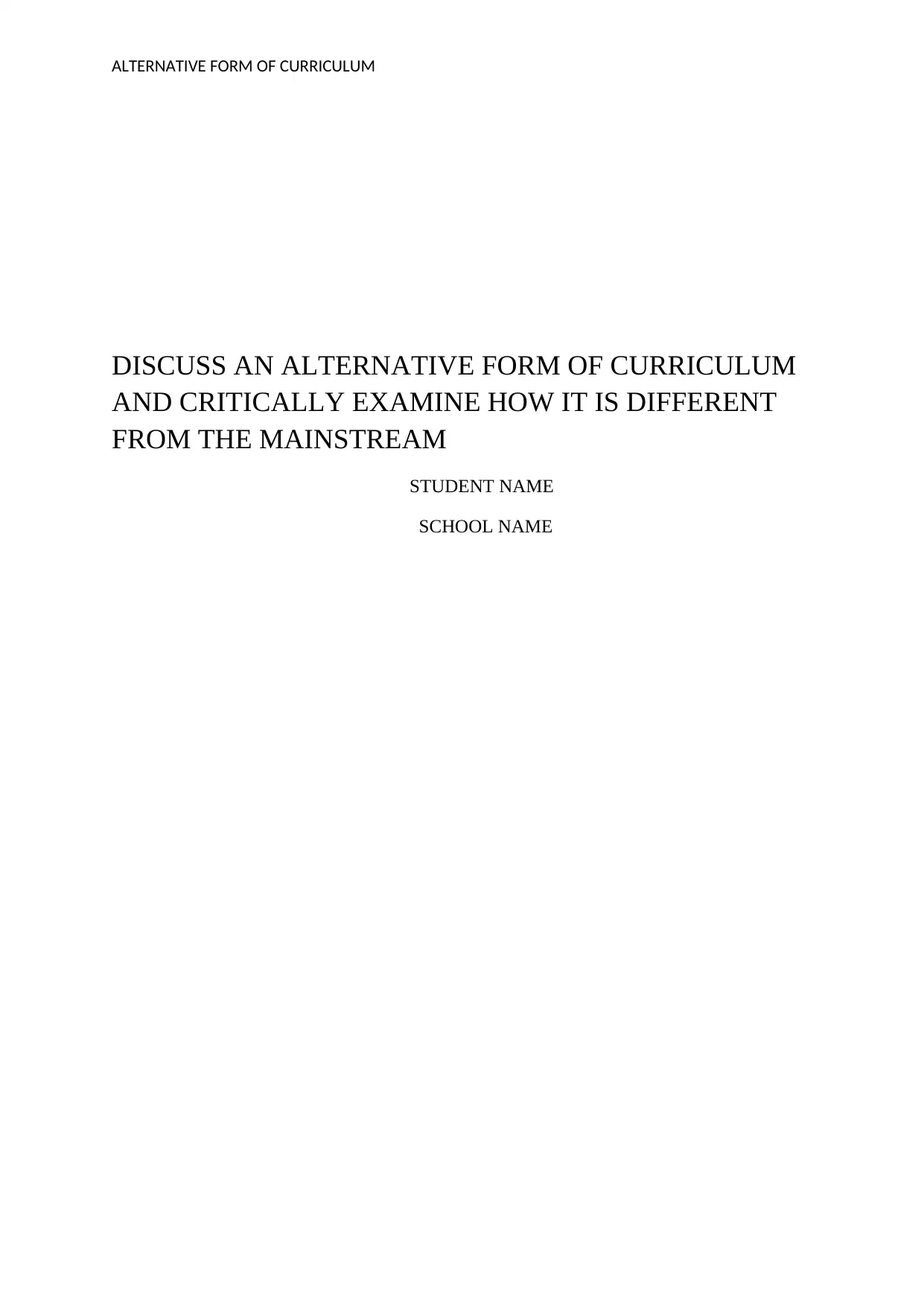
ALTERNATIVE FORM OF CURRICULUM
DISCUSS AN ALTERNATIVE FORM OF CURRICULUM
AND CRITICALLY EXAMINE HOW IT IS DIFFERENT
FROM THE MAINSTREAM
STUDENT NAME
SCHOOL NAME
DISCUSS AN ALTERNATIVE FORM OF CURRICULUM
AND CRITICALLY EXAMINE HOW IT IS DIFFERENT
FROM THE MAINSTREAM
STUDENT NAME
SCHOOL NAME
Paraphrase This Document
Need a fresh take? Get an instant paraphrase of this document with our AI Paraphraser
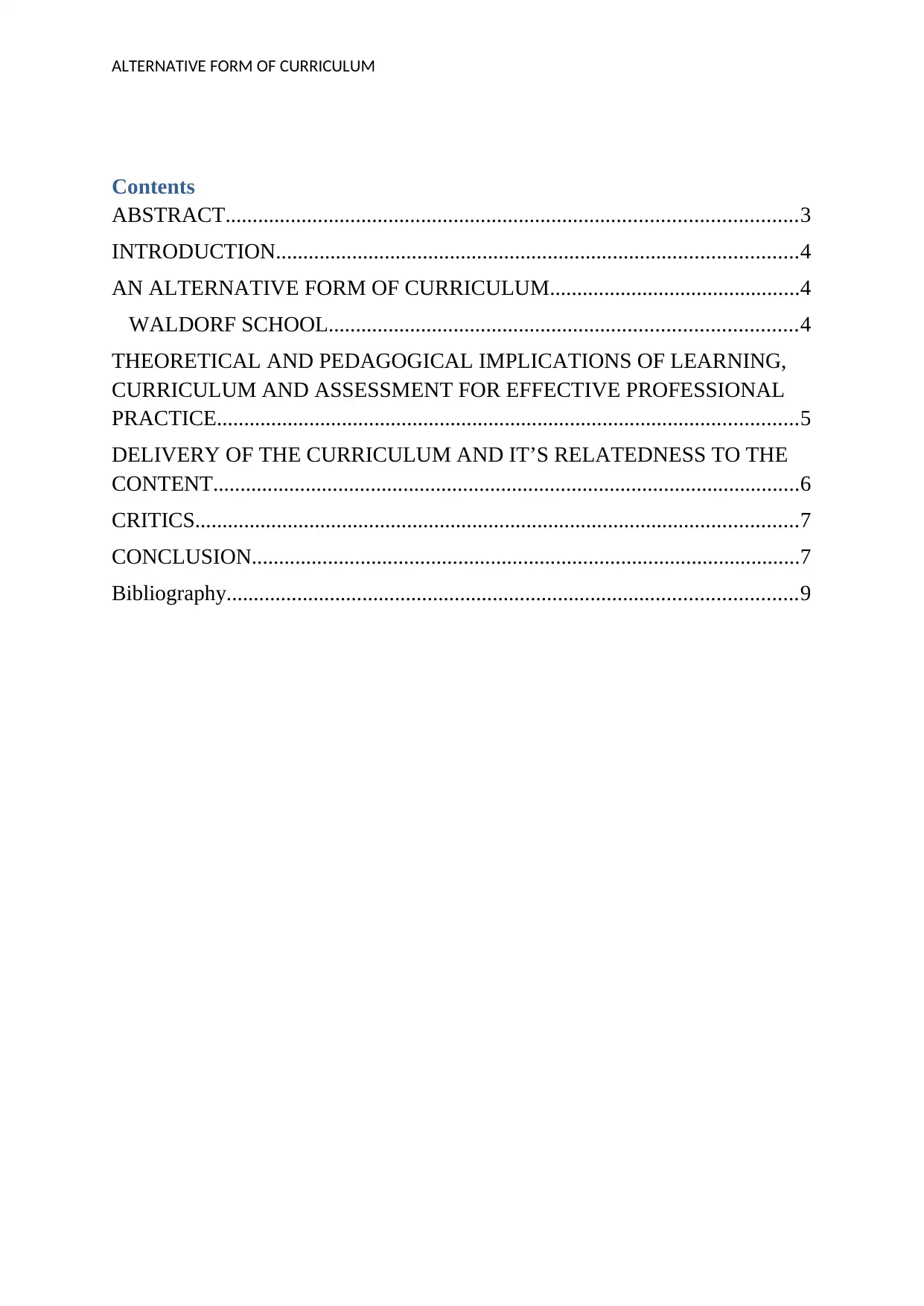
ALTERNATIVE FORM OF CURRICULUM
Contents
ABSTRACT.........................................................................................................3
INTRODUCTION................................................................................................4
AN ALTERNATIVE FORM OF CURRICULUM..............................................4
WALDORF SCHOOL......................................................................................4
THEORETICAL AND PEDAGOGICAL IMPLICATIONS OF LEARNING,
CURRICULUM AND ASSESSMENT FOR EFFECTIVE PROFESSIONAL
PRACTICE...........................................................................................................5
DELIVERY OF THE CURRICULUM AND IT’S RELATEDNESS TO THE
CONTENT............................................................................................................6
CRITICS...............................................................................................................7
CONCLUSION.....................................................................................................7
Bibliography.........................................................................................................9
Contents
ABSTRACT.........................................................................................................3
INTRODUCTION................................................................................................4
AN ALTERNATIVE FORM OF CURRICULUM..............................................4
WALDORF SCHOOL......................................................................................4
THEORETICAL AND PEDAGOGICAL IMPLICATIONS OF LEARNING,
CURRICULUM AND ASSESSMENT FOR EFFECTIVE PROFESSIONAL
PRACTICE...........................................................................................................5
DELIVERY OF THE CURRICULUM AND IT’S RELATEDNESS TO THE
CONTENT............................................................................................................6
CRITICS...............................................................................................................7
CONCLUSION.....................................................................................................7
Bibliography.........................................................................................................9
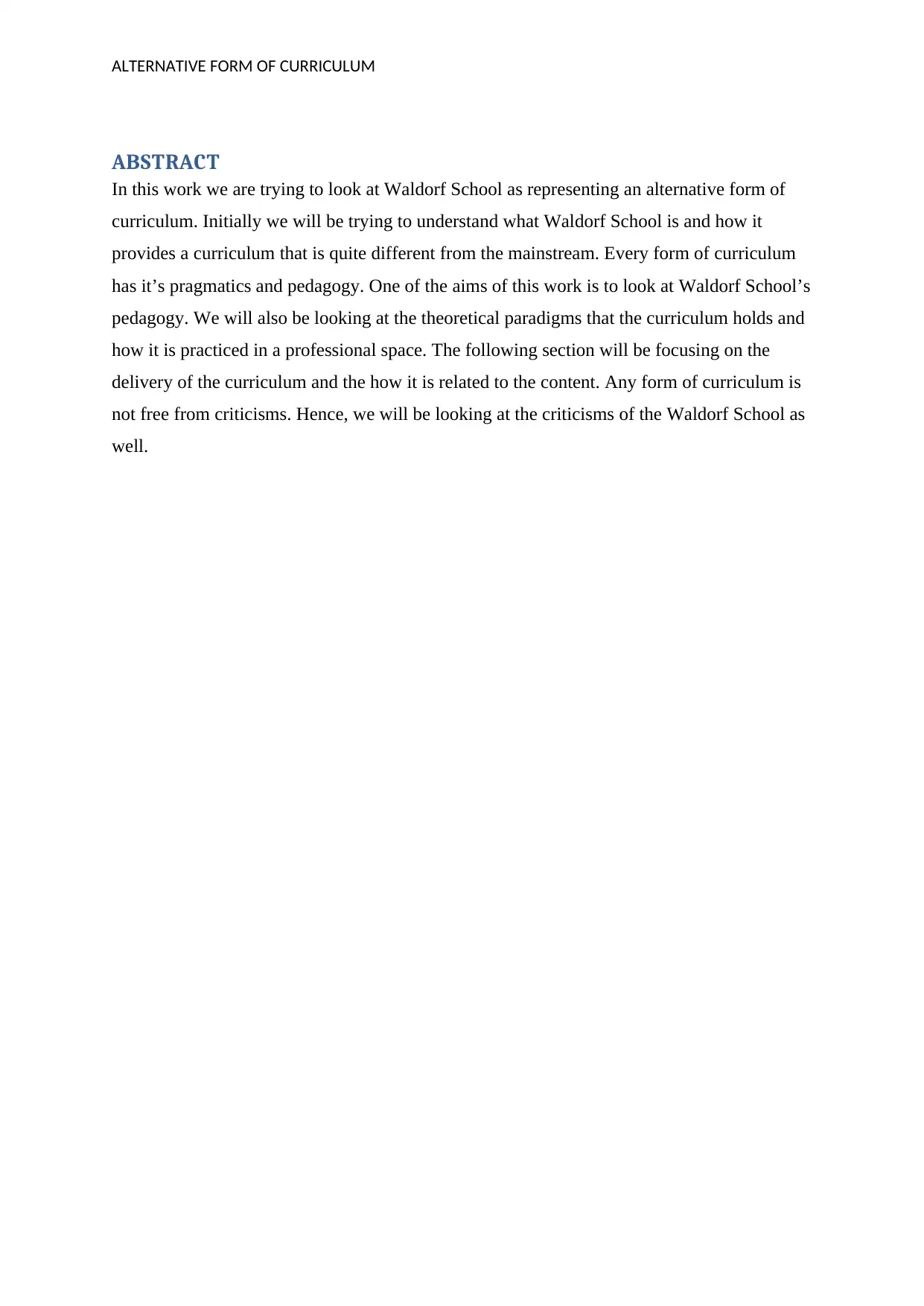
ALTERNATIVE FORM OF CURRICULUM
ABSTRACT
In this work we are trying to look at Waldorf School as representing an alternative form of
curriculum. Initially we will be trying to understand what Waldorf School is and how it
provides a curriculum that is quite different from the mainstream. Every form of curriculum
has it’s pragmatics and pedagogy. One of the aims of this work is to look at Waldorf School’s
pedagogy. We will also be looking at the theoretical paradigms that the curriculum holds and
how it is practiced in a professional space. The following section will be focusing on the
delivery of the curriculum and the how it is related to the content. Any form of curriculum is
not free from criticisms. Hence, we will be looking at the criticisms of the Waldorf School as
well.
ABSTRACT
In this work we are trying to look at Waldorf School as representing an alternative form of
curriculum. Initially we will be trying to understand what Waldorf School is and how it
provides a curriculum that is quite different from the mainstream. Every form of curriculum
has it’s pragmatics and pedagogy. One of the aims of this work is to look at Waldorf School’s
pedagogy. We will also be looking at the theoretical paradigms that the curriculum holds and
how it is practiced in a professional space. The following section will be focusing on the
delivery of the curriculum and the how it is related to the content. Any form of curriculum is
not free from criticisms. Hence, we will be looking at the criticisms of the Waldorf School as
well.
⊘ This is a preview!⊘
Do you want full access?
Subscribe today to unlock all pages.

Trusted by 1+ million students worldwide
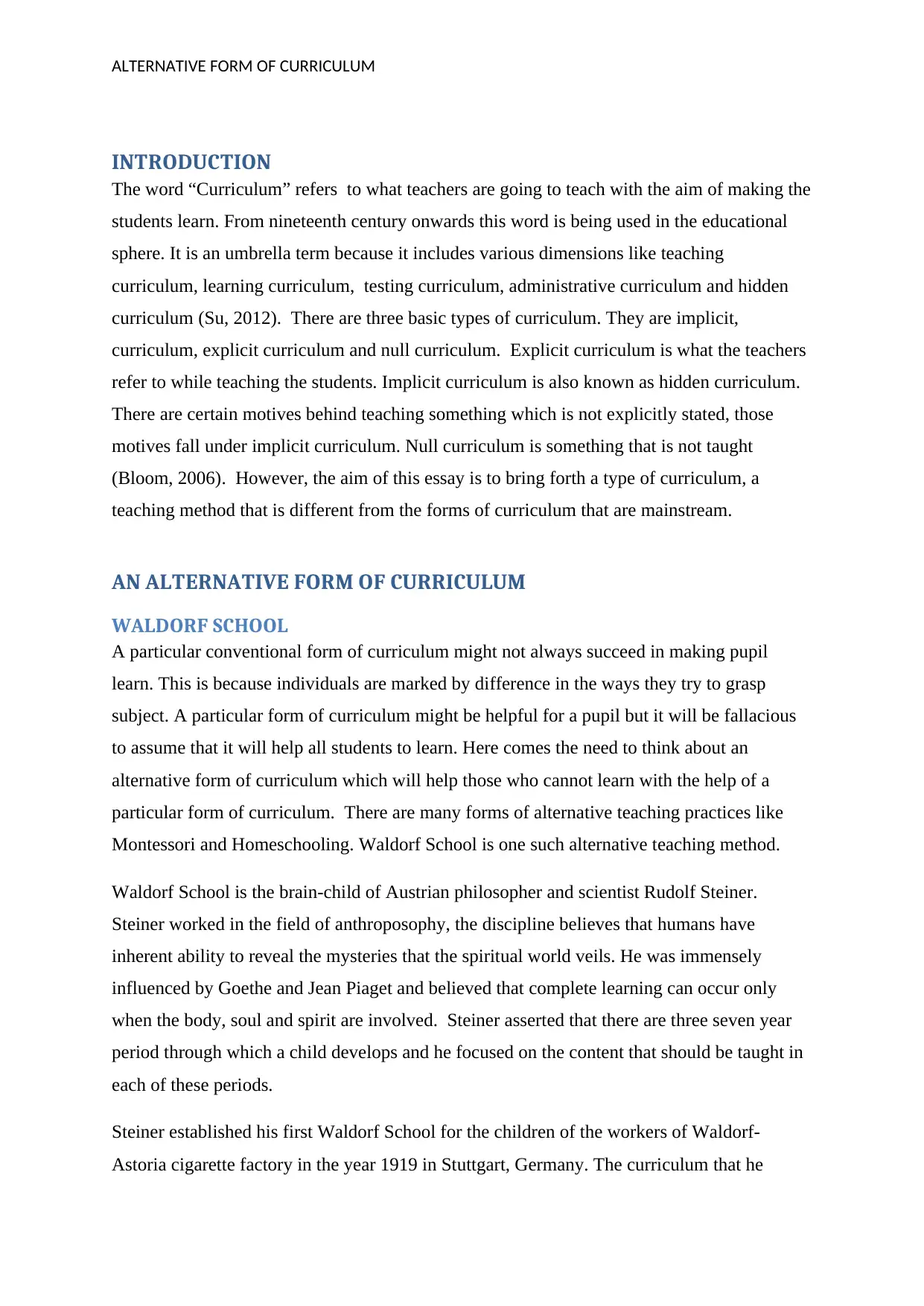
ALTERNATIVE FORM OF CURRICULUM
INTRODUCTION
The word “Curriculum” refers to what teachers are going to teach with the aim of making the
students learn. From nineteenth century onwards this word is being used in the educational
sphere. It is an umbrella term because it includes various dimensions like teaching
curriculum, learning curriculum, testing curriculum, administrative curriculum and hidden
curriculum (Su, 2012). There are three basic types of curriculum. They are implicit,
curriculum, explicit curriculum and null curriculum. Explicit curriculum is what the teachers
refer to while teaching the students. Implicit curriculum is also known as hidden curriculum.
There are certain motives behind teaching something which is not explicitly stated, those
motives fall under implicit curriculum. Null curriculum is something that is not taught
(Bloom, 2006). However, the aim of this essay is to bring forth a type of curriculum, a
teaching method that is different from the forms of curriculum that are mainstream.
AN ALTERNATIVE FORM OF CURRICULUM
WALDORF SCHOOL
A particular conventional form of curriculum might not always succeed in making pupil
learn. This is because individuals are marked by difference in the ways they try to grasp
subject. A particular form of curriculum might be helpful for a pupil but it will be fallacious
to assume that it will help all students to learn. Here comes the need to think about an
alternative form of curriculum which will help those who cannot learn with the help of a
particular form of curriculum. There are many forms of alternative teaching practices like
Montessori and Homeschooling. Waldorf School is one such alternative teaching method.
Waldorf School is the brain-child of Austrian philosopher and scientist Rudolf Steiner.
Steiner worked in the field of anthroposophy, the discipline believes that humans have
inherent ability to reveal the mysteries that the spiritual world veils. He was immensely
influenced by Goethe and Jean Piaget and believed that complete learning can occur only
when the body, soul and spirit are involved. Steiner asserted that there are three seven year
period through which a child develops and he focused on the content that should be taught in
each of these periods.
Steiner established his first Waldorf School for the children of the workers of Waldorf-
Astoria cigarette factory in the year 1919 in Stuttgart, Germany. The curriculum that he
INTRODUCTION
The word “Curriculum” refers to what teachers are going to teach with the aim of making the
students learn. From nineteenth century onwards this word is being used in the educational
sphere. It is an umbrella term because it includes various dimensions like teaching
curriculum, learning curriculum, testing curriculum, administrative curriculum and hidden
curriculum (Su, 2012). There are three basic types of curriculum. They are implicit,
curriculum, explicit curriculum and null curriculum. Explicit curriculum is what the teachers
refer to while teaching the students. Implicit curriculum is also known as hidden curriculum.
There are certain motives behind teaching something which is not explicitly stated, those
motives fall under implicit curriculum. Null curriculum is something that is not taught
(Bloom, 2006). However, the aim of this essay is to bring forth a type of curriculum, a
teaching method that is different from the forms of curriculum that are mainstream.
AN ALTERNATIVE FORM OF CURRICULUM
WALDORF SCHOOL
A particular conventional form of curriculum might not always succeed in making pupil
learn. This is because individuals are marked by difference in the ways they try to grasp
subject. A particular form of curriculum might be helpful for a pupil but it will be fallacious
to assume that it will help all students to learn. Here comes the need to think about an
alternative form of curriculum which will help those who cannot learn with the help of a
particular form of curriculum. There are many forms of alternative teaching practices like
Montessori and Homeschooling. Waldorf School is one such alternative teaching method.
Waldorf School is the brain-child of Austrian philosopher and scientist Rudolf Steiner.
Steiner worked in the field of anthroposophy, the discipline believes that humans have
inherent ability to reveal the mysteries that the spiritual world veils. He was immensely
influenced by Goethe and Jean Piaget and believed that complete learning can occur only
when the body, soul and spirit are involved. Steiner asserted that there are three seven year
period through which a child develops and he focused on the content that should be taught in
each of these periods.
Steiner established his first Waldorf School for the children of the workers of Waldorf-
Astoria cigarette factory in the year 1919 in Stuttgart, Germany. The curriculum that he
Paraphrase This Document
Need a fresh take? Get an instant paraphrase of this document with our AI Paraphraser
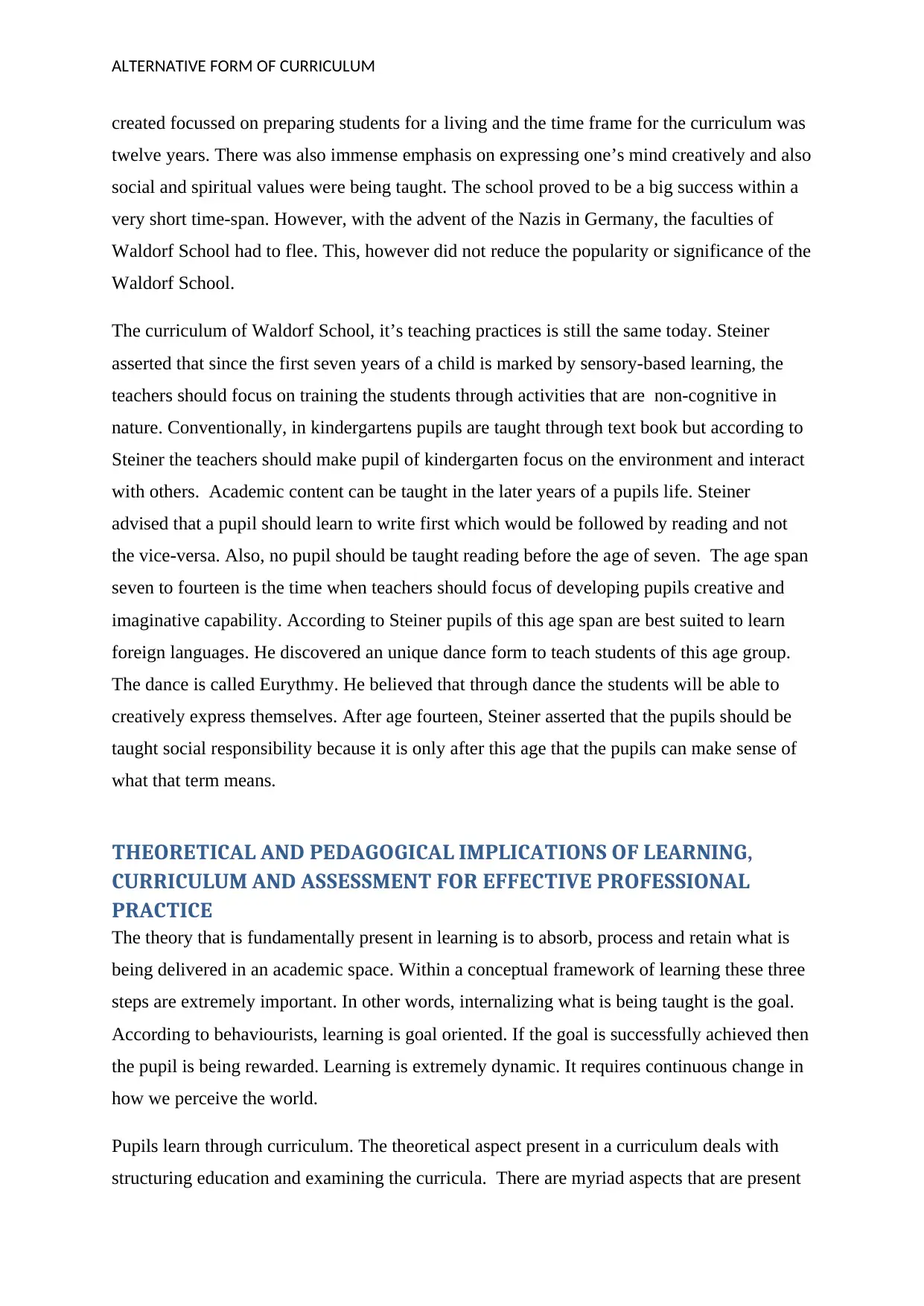
ALTERNATIVE FORM OF CURRICULUM
created focussed on preparing students for a living and the time frame for the curriculum was
twelve years. There was also immense emphasis on expressing one’s mind creatively and also
social and spiritual values were being taught. The school proved to be a big success within a
very short time-span. However, with the advent of the Nazis in Germany, the faculties of
Waldorf School had to flee. This, however did not reduce the popularity or significance of the
Waldorf School.
The curriculum of Waldorf School, it’s teaching practices is still the same today. Steiner
asserted that since the first seven years of a child is marked by sensory-based learning, the
teachers should focus on training the students through activities that are non-cognitive in
nature. Conventionally, in kindergartens pupils are taught through text book but according to
Steiner the teachers should make pupil of kindergarten focus on the environment and interact
with others. Academic content can be taught in the later years of a pupils life. Steiner
advised that a pupil should learn to write first which would be followed by reading and not
the vice-versa. Also, no pupil should be taught reading before the age of seven. The age span
seven to fourteen is the time when teachers should focus of developing pupils creative and
imaginative capability. According to Steiner pupils of this age span are best suited to learn
foreign languages. He discovered an unique dance form to teach students of this age group.
The dance is called Eurythmy. He believed that through dance the students will be able to
creatively express themselves. After age fourteen, Steiner asserted that the pupils should be
taught social responsibility because it is only after this age that the pupils can make sense of
what that term means.
THEORETICAL AND PEDAGOGICAL IMPLICATIONS OF LEARNING,
CURRICULUM AND ASSESSMENT FOR EFFECTIVE PROFESSIONAL
PRACTICE
The theory that is fundamentally present in learning is to absorb, process and retain what is
being delivered in an academic space. Within a conceptual framework of learning these three
steps are extremely important. In other words, internalizing what is being taught is the goal.
According to behaviourists, learning is goal oriented. If the goal is successfully achieved then
the pupil is being rewarded. Learning is extremely dynamic. It requires continuous change in
how we perceive the world.
Pupils learn through curriculum. The theoretical aspect present in a curriculum deals with
structuring education and examining the curricula. There are myriad aspects that are present
created focussed on preparing students for a living and the time frame for the curriculum was
twelve years. There was also immense emphasis on expressing one’s mind creatively and also
social and spiritual values were being taught. The school proved to be a big success within a
very short time-span. However, with the advent of the Nazis in Germany, the faculties of
Waldorf School had to flee. This, however did not reduce the popularity or significance of the
Waldorf School.
The curriculum of Waldorf School, it’s teaching practices is still the same today. Steiner
asserted that since the first seven years of a child is marked by sensory-based learning, the
teachers should focus on training the students through activities that are non-cognitive in
nature. Conventionally, in kindergartens pupils are taught through text book but according to
Steiner the teachers should make pupil of kindergarten focus on the environment and interact
with others. Academic content can be taught in the later years of a pupils life. Steiner
advised that a pupil should learn to write first which would be followed by reading and not
the vice-versa. Also, no pupil should be taught reading before the age of seven. The age span
seven to fourteen is the time when teachers should focus of developing pupils creative and
imaginative capability. According to Steiner pupils of this age span are best suited to learn
foreign languages. He discovered an unique dance form to teach students of this age group.
The dance is called Eurythmy. He believed that through dance the students will be able to
creatively express themselves. After age fourteen, Steiner asserted that the pupils should be
taught social responsibility because it is only after this age that the pupils can make sense of
what that term means.
THEORETICAL AND PEDAGOGICAL IMPLICATIONS OF LEARNING,
CURRICULUM AND ASSESSMENT FOR EFFECTIVE PROFESSIONAL
PRACTICE
The theory that is fundamentally present in learning is to absorb, process and retain what is
being delivered in an academic space. Within a conceptual framework of learning these three
steps are extremely important. In other words, internalizing what is being taught is the goal.
According to behaviourists, learning is goal oriented. If the goal is successfully achieved then
the pupil is being rewarded. Learning is extremely dynamic. It requires continuous change in
how we perceive the world.
Pupils learn through curriculum. The theoretical aspect present in a curriculum deals with
structuring education and examining the curricula. There are myriad aspects that are present
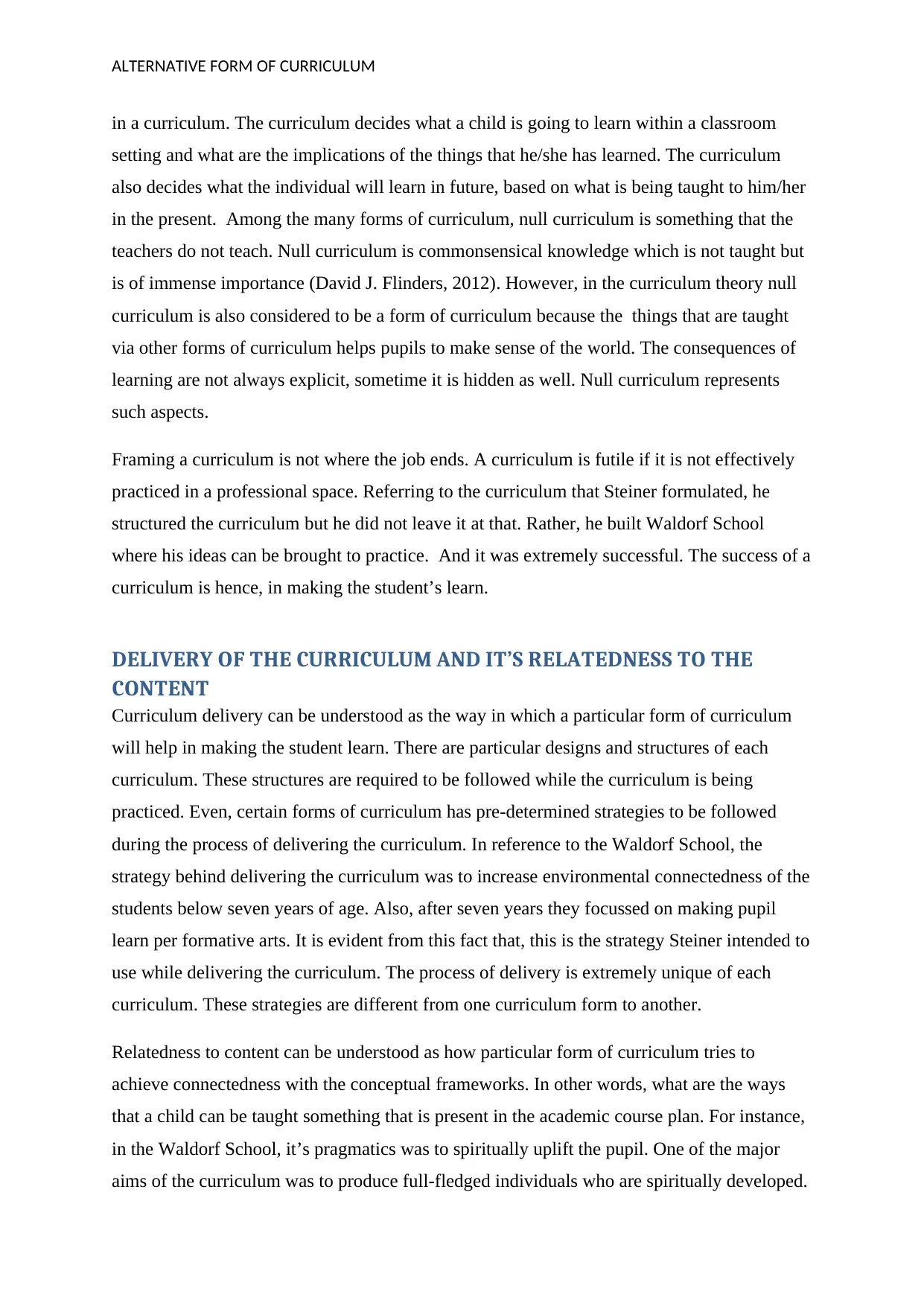
ALTERNATIVE FORM OF CURRICULUM
in a curriculum. The curriculum decides what a child is going to learn within a classroom
setting and what are the implications of the things that he/she has learned. The curriculum
also decides what the individual will learn in future, based on what is being taught to him/her
in the present. Among the many forms of curriculum, null curriculum is something that the
teachers do not teach. Null curriculum is commonsensical knowledge which is not taught but
is of immense importance (David J. Flinders, 2012). However, in the curriculum theory null
curriculum is also considered to be a form of curriculum because the things that are taught
via other forms of curriculum helps pupils to make sense of the world. The consequences of
learning are not always explicit, sometime it is hidden as well. Null curriculum represents
such aspects.
Framing a curriculum is not where the job ends. A curriculum is futile if it is not effectively
practiced in a professional space. Referring to the curriculum that Steiner formulated, he
structured the curriculum but he did not leave it at that. Rather, he built Waldorf School
where his ideas can be brought to practice. And it was extremely successful. The success of a
curriculum is hence, in making the student’s learn.
DELIVERY OF THE CURRICULUM AND IT’S RELATEDNESS TO THE
CONTENT
Curriculum delivery can be understood as the way in which a particular form of curriculum
will help in making the student learn. There are particular designs and structures of each
curriculum. These structures are required to be followed while the curriculum is being
practiced. Even, certain forms of curriculum has pre-determined strategies to be followed
during the process of delivering the curriculum. In reference to the Waldorf School, the
strategy behind delivering the curriculum was to increase environmental connectedness of the
students below seven years of age. Also, after seven years they focussed on making pupil
learn per formative arts. It is evident from this fact that, this is the strategy Steiner intended to
use while delivering the curriculum. The process of delivery is extremely unique of each
curriculum. These strategies are different from one curriculum form to another.
Relatedness to content can be understood as how particular form of curriculum tries to
achieve connectedness with the conceptual frameworks. In other words, what are the ways
that a child can be taught something that is present in the academic course plan. For instance,
in the Waldorf School, it’s pragmatics was to spiritually uplift the pupil. One of the major
aims of the curriculum was to produce full-fledged individuals who are spiritually developed.
in a curriculum. The curriculum decides what a child is going to learn within a classroom
setting and what are the implications of the things that he/she has learned. The curriculum
also decides what the individual will learn in future, based on what is being taught to him/her
in the present. Among the many forms of curriculum, null curriculum is something that the
teachers do not teach. Null curriculum is commonsensical knowledge which is not taught but
is of immense importance (David J. Flinders, 2012). However, in the curriculum theory null
curriculum is also considered to be a form of curriculum because the things that are taught
via other forms of curriculum helps pupils to make sense of the world. The consequences of
learning are not always explicit, sometime it is hidden as well. Null curriculum represents
such aspects.
Framing a curriculum is not where the job ends. A curriculum is futile if it is not effectively
practiced in a professional space. Referring to the curriculum that Steiner formulated, he
structured the curriculum but he did not leave it at that. Rather, he built Waldorf School
where his ideas can be brought to practice. And it was extremely successful. The success of a
curriculum is hence, in making the student’s learn.
DELIVERY OF THE CURRICULUM AND IT’S RELATEDNESS TO THE
CONTENT
Curriculum delivery can be understood as the way in which a particular form of curriculum
will help in making the student learn. There are particular designs and structures of each
curriculum. These structures are required to be followed while the curriculum is being
practiced. Even, certain forms of curriculum has pre-determined strategies to be followed
during the process of delivering the curriculum. In reference to the Waldorf School, the
strategy behind delivering the curriculum was to increase environmental connectedness of the
students below seven years of age. Also, after seven years they focussed on making pupil
learn per formative arts. It is evident from this fact that, this is the strategy Steiner intended to
use while delivering the curriculum. The process of delivery is extremely unique of each
curriculum. These strategies are different from one curriculum form to another.
Relatedness to content can be understood as how particular form of curriculum tries to
achieve connectedness with the conceptual frameworks. In other words, what are the ways
that a child can be taught something that is present in the academic course plan. For instance,
in the Waldorf School, it’s pragmatics was to spiritually uplift the pupil. One of the major
aims of the curriculum was to produce full-fledged individuals who are spiritually developed.
⊘ This is a preview!⊘
Do you want full access?
Subscribe today to unlock all pages.

Trusted by 1+ million students worldwide
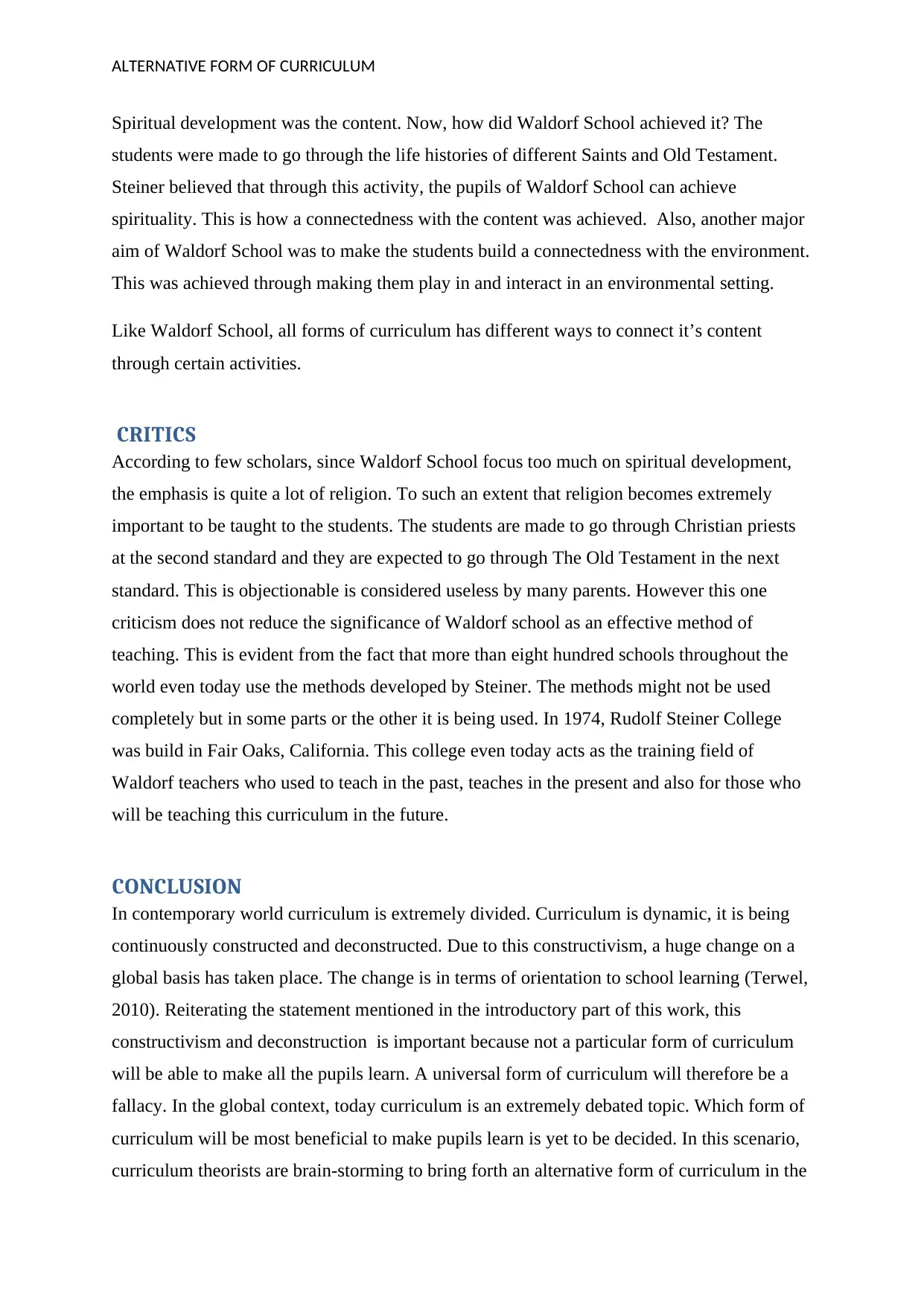
ALTERNATIVE FORM OF CURRICULUM
Spiritual development was the content. Now, how did Waldorf School achieved it? The
students were made to go through the life histories of different Saints and Old Testament.
Steiner believed that through this activity, the pupils of Waldorf School can achieve
spirituality. This is how a connectedness with the content was achieved. Also, another major
aim of Waldorf School was to make the students build a connectedness with the environment.
This was achieved through making them play in and interact in an environmental setting.
Like Waldorf School, all forms of curriculum has different ways to connect it’s content
through certain activities.
CRITICS
According to few scholars, since Waldorf School focus too much on spiritual development,
the emphasis is quite a lot of religion. To such an extent that religion becomes extremely
important to be taught to the students. The students are made to go through Christian priests
at the second standard and they are expected to go through The Old Testament in the next
standard. This is objectionable is considered useless by many parents. However this one
criticism does not reduce the significance of Waldorf school as an effective method of
teaching. This is evident from the fact that more than eight hundred schools throughout the
world even today use the methods developed by Steiner. The methods might not be used
completely but in some parts or the other it is being used. In 1974, Rudolf Steiner College
was build in Fair Oaks, California. This college even today acts as the training field of
Waldorf teachers who used to teach in the past, teaches in the present and also for those who
will be teaching this curriculum in the future.
CONCLUSION
In contemporary world curriculum is extremely divided. Curriculum is dynamic, it is being
continuously constructed and deconstructed. Due to this constructivism, a huge change on a
global basis has taken place. The change is in terms of orientation to school learning (Terwel,
2010). Reiterating the statement mentioned in the introductory part of this work, this
constructivism and deconstruction is important because not a particular form of curriculum
will be able to make all the pupils learn. A universal form of curriculum will therefore be a
fallacy. In the global context, today curriculum is an extremely debated topic. Which form of
curriculum will be most beneficial to make pupils learn is yet to be decided. In this scenario,
curriculum theorists are brain-storming to bring forth an alternative form of curriculum in the
Spiritual development was the content. Now, how did Waldorf School achieved it? The
students were made to go through the life histories of different Saints and Old Testament.
Steiner believed that through this activity, the pupils of Waldorf School can achieve
spirituality. This is how a connectedness with the content was achieved. Also, another major
aim of Waldorf School was to make the students build a connectedness with the environment.
This was achieved through making them play in and interact in an environmental setting.
Like Waldorf School, all forms of curriculum has different ways to connect it’s content
through certain activities.
CRITICS
According to few scholars, since Waldorf School focus too much on spiritual development,
the emphasis is quite a lot of religion. To such an extent that religion becomes extremely
important to be taught to the students. The students are made to go through Christian priests
at the second standard and they are expected to go through The Old Testament in the next
standard. This is objectionable is considered useless by many parents. However this one
criticism does not reduce the significance of Waldorf school as an effective method of
teaching. This is evident from the fact that more than eight hundred schools throughout the
world even today use the methods developed by Steiner. The methods might not be used
completely but in some parts or the other it is being used. In 1974, Rudolf Steiner College
was build in Fair Oaks, California. This college even today acts as the training field of
Waldorf teachers who used to teach in the past, teaches in the present and also for those who
will be teaching this curriculum in the future.
CONCLUSION
In contemporary world curriculum is extremely divided. Curriculum is dynamic, it is being
continuously constructed and deconstructed. Due to this constructivism, a huge change on a
global basis has taken place. The change is in terms of orientation to school learning (Terwel,
2010). Reiterating the statement mentioned in the introductory part of this work, this
constructivism and deconstruction is important because not a particular form of curriculum
will be able to make all the pupils learn. A universal form of curriculum will therefore be a
fallacy. In the global context, today curriculum is an extremely debated topic. Which form of
curriculum will be most beneficial to make pupils learn is yet to be decided. In this scenario,
curriculum theorists are brain-storming to bring forth an alternative form of curriculum in the
Paraphrase This Document
Need a fresh take? Get an instant paraphrase of this document with our AI Paraphraser
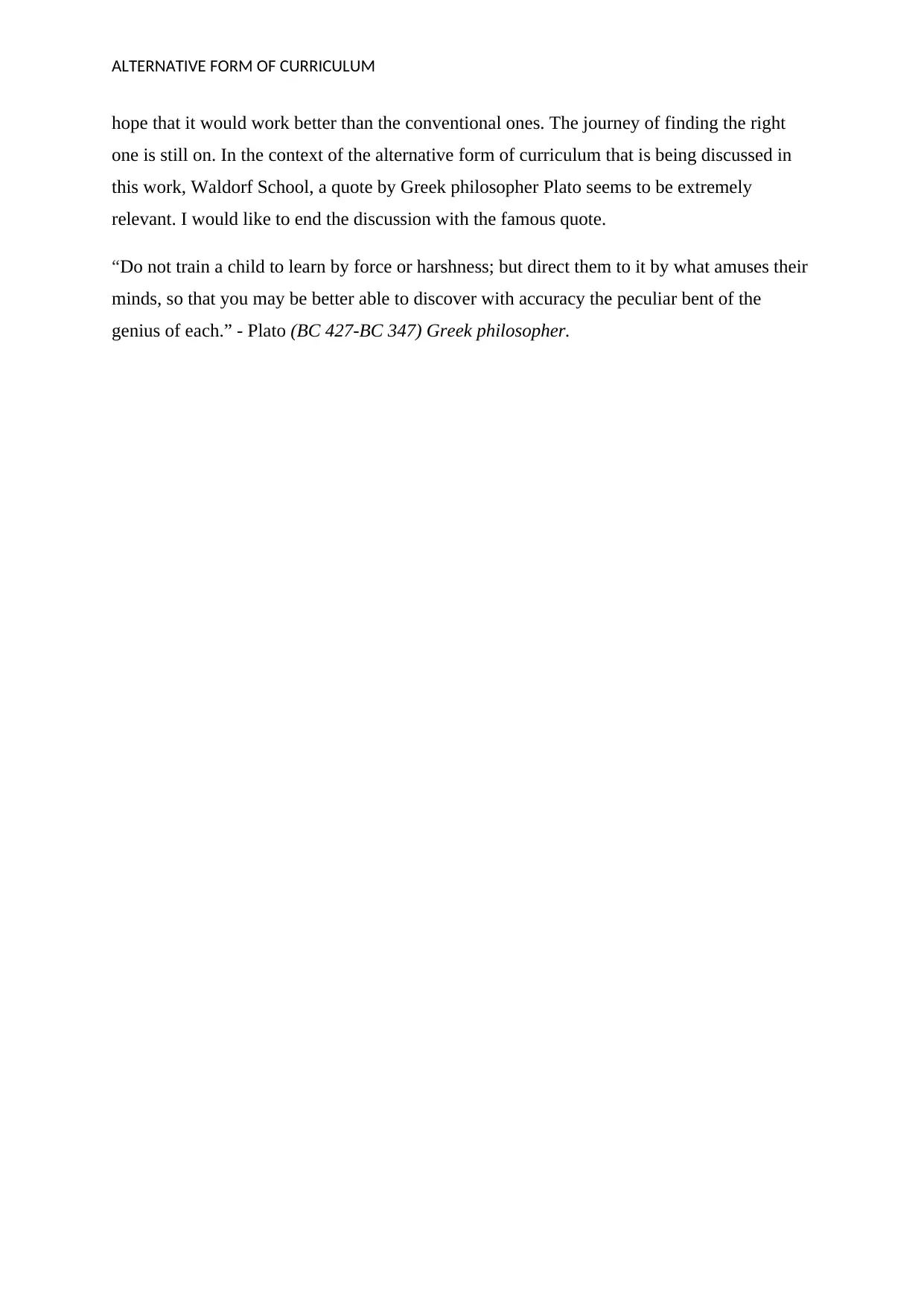
ALTERNATIVE FORM OF CURRICULUM
hope that it would work better than the conventional ones. The journey of finding the right
one is still on. In the context of the alternative form of curriculum that is being discussed in
this work, Waldorf School, a quote by Greek philosopher Plato seems to be extremely
relevant. I would like to end the discussion with the famous quote.
“Do not train a child to learn by force or harshness; but direct them to it by what amuses their
minds, so that you may be better able to discover with accuracy the peculiar bent of the
genius of each.” - Plato (BC 427-BC 347) Greek philosopher.
hope that it would work better than the conventional ones. The journey of finding the right
one is still on. In the context of the alternative form of curriculum that is being discussed in
this work, Waldorf School, a quote by Greek philosopher Plato seems to be extremely
relevant. I would like to end the discussion with the famous quote.
“Do not train a child to learn by force or harshness; but direct them to it by what amuses their
minds, so that you may be better able to discover with accuracy the peculiar bent of the
genius of each.” - Plato (BC 427-BC 347) Greek philosopher.
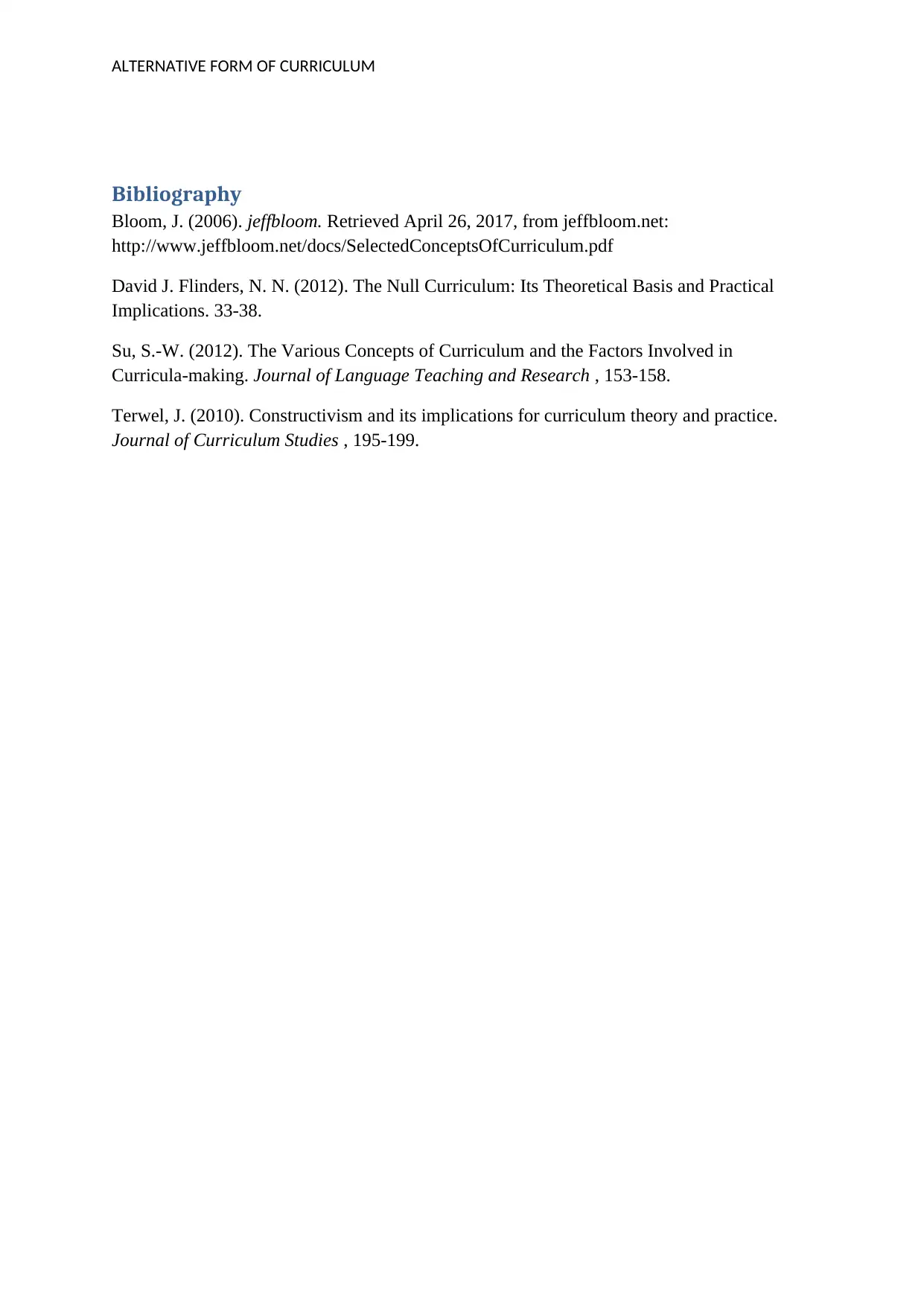
ALTERNATIVE FORM OF CURRICULUM
Bibliography
Bloom, J. (2006). jeffbloom. Retrieved April 26, 2017, from jeffbloom.net:
http://www.jeffbloom.net/docs/SelectedConceptsOfCurriculum.pdf
David J. Flinders, N. N. (2012). The Null Curriculum: Its Theoretical Basis and Practical
Implications. 33-38.
Su, S.-W. (2012). The Various Concepts of Curriculum and the Factors Involved in
Curricula-making. Journal of Language Teaching and Research , 153-158.
Terwel, J. (2010). Constructivism and its implications for curriculum theory and practice.
Journal of Curriculum Studies , 195-199.
Bibliography
Bloom, J. (2006). jeffbloom. Retrieved April 26, 2017, from jeffbloom.net:
http://www.jeffbloom.net/docs/SelectedConceptsOfCurriculum.pdf
David J. Flinders, N. N. (2012). The Null Curriculum: Its Theoretical Basis and Practical
Implications. 33-38.
Su, S.-W. (2012). The Various Concepts of Curriculum and the Factors Involved in
Curricula-making. Journal of Language Teaching and Research , 153-158.
Terwel, J. (2010). Constructivism and its implications for curriculum theory and practice.
Journal of Curriculum Studies , 195-199.
⊘ This is a preview!⊘
Do you want full access?
Subscribe today to unlock all pages.

Trusted by 1+ million students worldwide
1 out of 9
Your All-in-One AI-Powered Toolkit for Academic Success.
+13062052269
info@desklib.com
Available 24*7 on WhatsApp / Email
![[object Object]](/_next/static/media/star-bottom.7253800d.svg)
Unlock your academic potential
Copyright © 2020–2025 A2Z Services. All Rights Reserved. Developed and managed by ZUCOL.